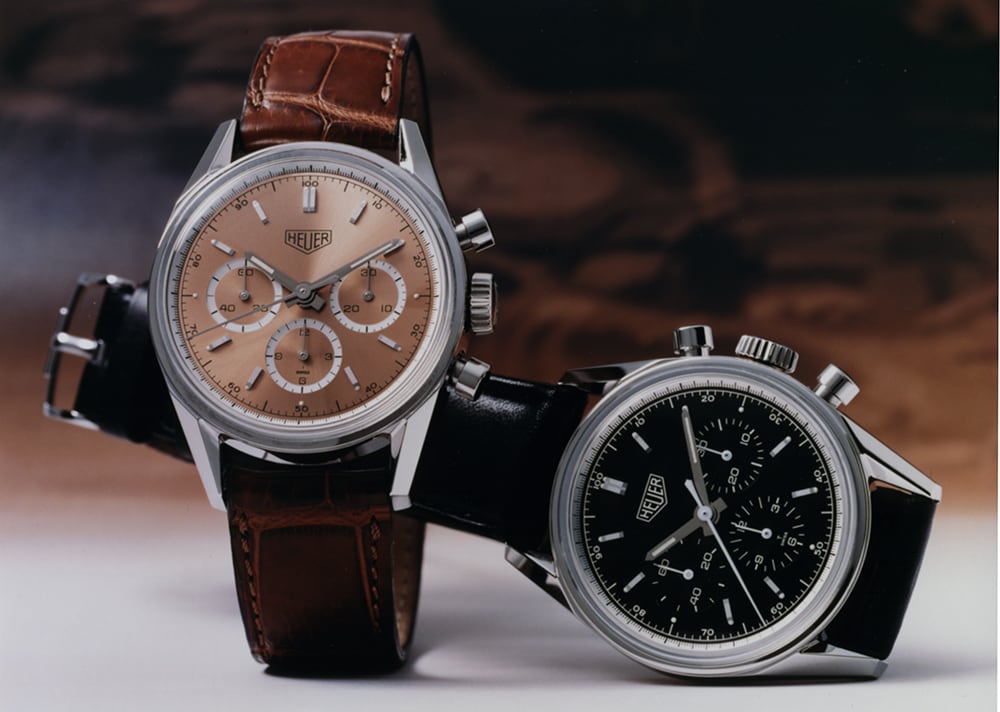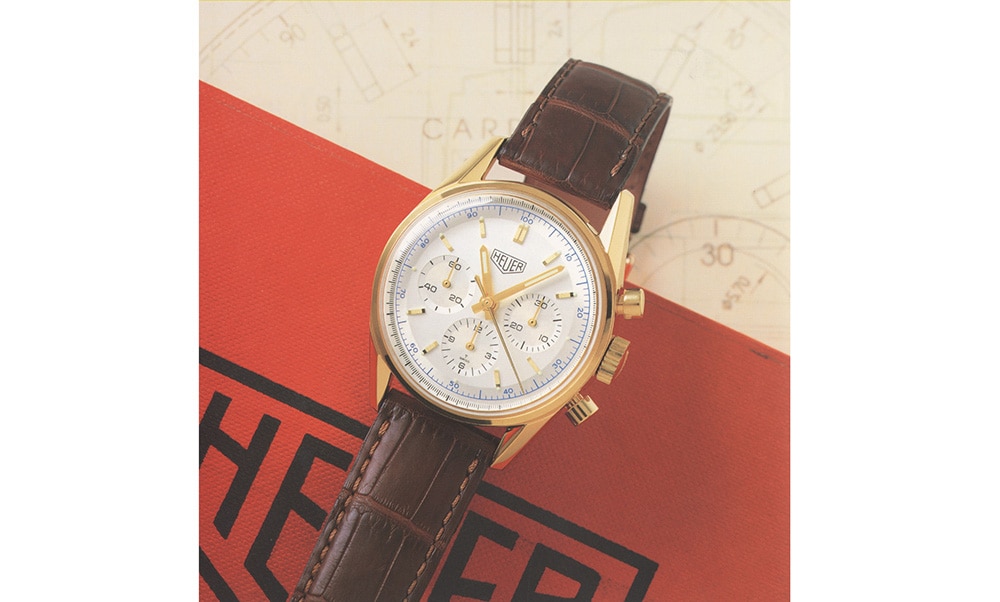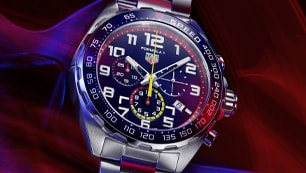TAG HEUER CARRERA (1996 TO CURRENT)
TAG Heuer introduced the first re-edition of the Carrera in 1996, following a cautious approach that resulted in what was almost a one-to-one copy of the first Carrera from 1963. In more than two decades that have followed, we saw the Carrera first inching away from these literal homages, and then creating bold new models, as the Carrera collection showed its own vision of what a modern sports chronograph should be. Through its 32 years, features common to all the TAG Heuer Carreras have included the powerful geometry of the case, with its unique lugs, and the legibility and reliability of the chronograph in the most demanding racing conditions.
In our posting covering the vintage Heuer Carrera chronographs, we covered the five generations of Carrera chronographs produced over the period from 1963, when the first Carrera was introduced, to 1985 when the last Carrera appeared in a TAG Heuer catalog, before a break in production. The first five generations of the Carrera were comprised of the first generation, the original Carreras in traditional round cases, the second generation, C-Shape cases introduced in 1969 to house the new automatic movements, the third generation, four barrel-shaped Carreras, powered by the Calibre 12 movement, the fourth generation, introduced in 1978 to house a series of quartz-powered Carreras, and the fifth generation, two chronographs introduced in 1984, which were powered by the Lemania 5100 movement.
Now, we continue this history of the Carrera chronograph, picking up with the sixth generation, introduced in 1996, and continuing to the models introduced in 2015 and 2019, which are drawn from the twelfth and thirteenth generations.
Since the re-introduction of the Carrera in 1996, we saw TAG Heuer develop the Carrera collection, from a simple homage to the original models, and further with models that take on their own identity, incorporating the most advanced materials and time-keeping technologies, while always remaining true to the Carrera origin.

FIRST CARRERA RE-EDITIONS: 1996- 2002
As described in our posting covering the very first re-editions of the Carrera, in 1996 TAG Heuer produced three models of the Carrera -- the black-dial Carrera in a stainless steel case (CS3111), the white-dial Carrera in a stainless steel case (CS3110) and the white-dial Carrera an 18 karat gold case (CS3140).
This first Carrera re-edition was true to the original Heuer Carrera from 1963 in almost every aspect, from the 36mm stainless steel case, to the geometry of the pushers and crown to the dial and sub-dial design. All three versions of the 1996 Carrera re-edition have the decimal minutes scale printed on the dial, which was one of the versions available in 1963. The “telltale” to distinguish the re-edition from the original models from 1963 is that the original models had the text “Carrera” on the dial, above the Heuer shield, while the re-edition does not.
In the late 1990s, the range expanded to include two models, one with a black dial and one with a salmon dial, featuring contrasting rings around all three registers. While the addition of these rings may be a relatively small detail, it signaled that TAG Heuer would be moving from the one-to-one type of re-editions to models that would combine explore the full potential of the range.

“CLASSIC” CARRERAS: 2000 - 2002
The start of the new millennium saw a major change at TAG Heuer, with the company bought by French luxury conglomerate LVMH, who quickly installed a new CEO: Jean-Christophe Babin. The new management team took two steps that had a profound impact on the product range- firstly, they moved the Carrera and Monaco away from being limited edition watches to part of the permanent range, and secondly, the decision was made to offer Jack Heuer the position of Honorary Chairman at TAG Heuer.
The Carrera would quickly move from being a retro novelty to being the centerpiece of the TAG Heuer range, a strategy that continues today.
While the 1996 re-edition range was faithful to the original 1963 Carrera, the new designs added to the “Classics Collection” in 2000 were not constrained to the stylistic elements of any historic model. In addition, the new models moved from manual-winding movements to automatic movements.
There were two variants of the newest Carrera: a three-hand watch with a white dial (WV2112) and a GMT version (WS2113) that used a black dial, which the fourth hand allowing the user to track the time in a second time zone. Moving from the dials of the earlier models, which had minimal decoration, these two “Classic” models both used Arabic numerals for the hours, with a “railroad track” to mark the minutes.
HERITAGE-INSPIRED MODELS IN 39 MM CASES: 2002-2008
While the first re-editions of the Carrera were a huge success, the 36 millimeter cases were small by prevailing standards. This was addressed in 2002 when TAG Heuer launched a heritage-inspired Carrera collection which borrowed the design of the original, with the case expanded to 39 millimeters. The three models included one with a white dial (CV2110) and two with black dials, one all black (CV2111) and one with contrasting “Daytona rings.” The new watches were branded TAG Heuer and fitted with a Calibre 17 automatic movement, with a date positioned at 4:30.
There were two special editions in this generation, both using two-register dials. In 2004, TAG Heuer issued a model to mark the 40th anniversary of the Carrera (CV2117). This model incorporated the color scheme that came to be known as the “Jack Heuer colors”, a combination of dark and light grays, with red accents.
In 2005, TAG Heuer issued another two register model (CV2118) in honor of the Enstall Classic, an Austrian rally for classic cars. The defining features of this model were the bright red stripes on the chronograph minute recorder and the red chronograph second hand.
THE CARRERA GROWS AND GETS A BEZEL: 2004 – 2012
In 2004, TAG Heuer introduced a new version of the Carrera that marked a clear departure from all the preceding models. Rather than closely following the design of previous models, the newest Carrera was the company’s statement of how a modern Carrera could work. This generation marked the transition from what we might call “retro designs” to contemporary designs informed by the past.
The new series (CV20XX) boasted a 41mm case with the classic Carrera lugs and Chronograph-pusher design. The most significant change was the addition of a fixed external bezel, a first for the Carrera, marked with a Tachymeter scale. While racers rarely have the opportunity to track their time over a measured mile, the tachymeter scale on the dial or bezel of a watch has become the de facto symbol of racing. From the start, Heuer had offered tachymeter scales on the Carrera, but they were printed on the dial, and no Carrera had ever had an external bezel.
The dial arrangement – with three registers at 12, 9 and 6 o’clock and a date at 3 o’clock -- was dictated by the use of the Calibre 16 movement, the first time that TAG Heuer had fitted this movement to a Carrera.
It was also during the 2000s that TAG Heuer began to launch concept watches, an idea often used in the car industry. One of the first concept watches was the Carrera Calibre 360, which had a register marked in 1/100 second increments. The Carrera Calibre 360 flagged TAG Heuer’s ambitions as a manufacture, and was a statement that the company would not only manufacture its own movements for its standard models, but would explore the limits of haute horlogerie in a small workshop
CALIBRE 1887 and HAUTE HOROLERIE: 2010- 2016
The introduction of a new Carrera in 2010 would mark “firsts”, both for TAG Heuer as a company and for the Carrera, as the brand’s flagship collection. For the first time ever, the Carrera chronograph would be powered by a movement produced by the company. No more Valjoux, no more ETA, no more Lemania. TAG Heuer would produce the Calibre 1887 movement itself, eliminating any dependence on third-party suppliers.
Just as the use of the Calibre 1887 movement would mark a new beginning for TAG Heuer, it seemed that the designers had hit the reset button on the Carrera. The new Calibre 1887 movement would not power an evolution of any models in the catalogue, rather the precedent for the Calibre 1887 Carrera would be the very first Carrera, from 1963.
The new Carrera would incorporate each of the key elements that made the original Carrera the icon of simplicity and functionality; twelve simple applied markers for the hours, polished stainless steel matchstick hands, inner bezel marked for minutes and 1/5 seconds (although the Calibre 1887 shows 1/4 second divisions, consistent with the 28,800 VPH movement), and stainless steel case with distinctive angled lugs. The newest Carrera was clearly inspired by the oldest Carrera, and while the combination of design components from one era to the next will not always result an object that reflects beauty of the original object, it worked perfectly with the Carrera Calibre 1887. This chronograph looks as though it was drawn by the very same hand that drew the first Carreras, almost 50 years ago.
While the Calibre 1887 Carrera was the core of TAG Heuer’s Carrera collection, TAG Heuer would also take the Carrera in a different direction. As TAG Heuer began to showcase its watchmaking skills with the Mikro- platform watches, it chose the Carrera as the base for these new haute horologerie designs. TAG Heuer’s range of high-precision mechanical Chronographs, stretching to 5/ 10,000th of a second, set a benchmark that no other brand was able to match.
SKELETON DIALS: 2015- CURRENT
In 2015 the first Carrera Heuer-01 as launched, representing the vision of new CEO Jean-Claude Biver. The Carrera Heuer-01 uses a modified version of the Calibre 1887 (Heuer 01) and used a modular construction case with open-skeleton dial.
Further models followed in 2016, such as the Blue Touch Edition, as well as a 43mm model with a more traditional dial.
With the Heuer 01 movement discontinued in 2018, the range of skeleton dial Carrera chronographs was revised, now powered by the Heuer 02 movement. The Heuer 02 movement provides a classical 3-6-9 dial configuration, with a date at 6 o’clock. Included in this new Carrera range was a GMT chronograph, the first GMT chronograph to be produced by Heuer since the Autavia in the mid-1980s.
THE GLASSBOX CASE: 2015 - CURRENT
At the same time that TAG Heuer was developing Carrera chronographs with large cases (43 to 45 mm) and skeleton dials, the company also launched a series of heritage-style Carrera watches, whose design ethos is similar to the 1996 re-editions.
This Carrera series all features a 39 mm case, with a raised glass domed crystal, which TAG Heuer refers to as a “glassbox”. The new style case made its debut in 2015, with the Carrera Calibre 18 Telemeter chronograph, which featured a white dial and contrasting registers. Summer 2017 saw two limited edition Carrera chronographs housed in the “glassbox” case, both of them powered by the Calibre 18 movement -- the TAG Heuer x Hodinkee Limited Edition tribute to the Skipper and the TAG Heuer x Revolution “Blue Dreamer”. The Glassbox Carrera made the move from two registers to three in November 2018, when Hiroshi Fujiwara designed the TAG Heuer x Fragment Design Carrera, the first Glassbox model to be powered by the Heuer 02 movement. The Fragment Carrera was inspired by an all-black Carrera from the late 1960s. In 2020, to celebrate the 160th anniversary of the brand, TAG Heuer launched two new Glassbox Carreras powered by the Heuer 02 movement. The Silver limited edition with its bright silver dial evoked the simplicity of the very first Carrera from 1963, while the “Montreal” limited edition combined the joyful colors of the Montreal chronograph from the early 1970s with the elegance of the Carrera.
The year 2021 would see two additional Glassbox Carreras powered by the Heuer 02 movement, one derived from the Carrera 45 Dato chronograph (circa 1967) and the other had a teal dial, an entirely new color for TAG Heuer.
2019-2023
TAG Heuer redesigned the Carrera case to produce the thirteenth generation of the model, with the new 41 millimeter case featuring a fixed tachymeter bezel, as well as shorter lugs and a lower profile to provide a thinner look. The new approach to design also extended to the dial, with much of the dial text removed, leaving only the TAG Heuer logo, the Carrera name and the word “Automatic“. These Carreras were powered by the Calibre 16 movement, featuring three registers at 12, 9 and 6 o’clock and a date at 3 o’clock. Models include a version with a black dial (CBM2110) as well as a model with a sunray blue dial (CBM2112).
In July 2020, TAG Heuer introduced its Carrera “Sport Chronograph” collection, four 44 millimeter models with fixed tachymeter bezels, all powered by the Heuer 02 movement. These models have larger chronograph recorders for hours (at 9 o’clock) and minutes (at 3 o’clock), with a smaller running seconds recorder at 6 o’clock, with a date window. Dial / bezel combinations include black dial with black ceramic bezel (CBN2A1B); blue dial with blue ceramic bezel (CBN2A1A); green dial with steel bezel (CBN2A10); and black and gold dial with black and gold bezel (CBN2A5A).
In September 2020, TAG Heuer introduced a new version of the Carrera with a case that followed the basic geometry of the “Sport” model, except that the deletion of the bezel produced a 42 millimeter case, rather than the 44 millimeter case of the “Sport” model. As on the “Sport” model, power is provided by the Heuer 02 movement, with the same use of larger recorders for chronograph hours and minutes and a smaller recorder for running seconds and the date window. Dials on four 42 millimeter versions are black with opaline finish (CBN2010), silver with opaline finish and rose-gold accents (CBN2013), blue with sunray finish (CBN2011) and anthracite with sunray finish (CBN2012).









